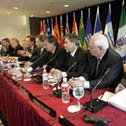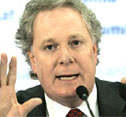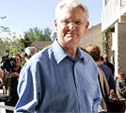East is east and west is west .. take me where the cement grows, in Gimli, Manitoba
May 31st, 2006 | By Counterweights Editors | Category: Canadian Provinces The classic two solitudes in Canada are French and English.
The classic two solitudes in Canada are French and English.
But today’s blogosphere is full of the other great schism between East and West.
And, as crowds in Kabul, Afghanistan shout “Death to America,” the supermarket tabloids say George W. Bush has taken up drinking again.
Meanwhile, this week the Western Canadian premiers are talking up a storm at Gimli, Manitoba.
Ultimately there will be guests from as far away as Eastern Canada, Mexico, and the USA.
You might guess that maybe even in the true north red states and blue states are the real two solitudes nowadays. On the other hand, maybe it actually is a bit more complicated than that?
Do Rafe Mair in BC and Geoffrey Stevens in Ontario live on the same planet?
 As deep background to all the talk at Gimli, it is interesting to set two recent Canadian Internet comment pieces side by side. The first, entitled “Harper May Slip on Oil,” is by Rafe Mair from BC, and it appeared in The Tyee on May 29. The second, by Geoffrey Stevens from Ontario, appeared a mere 20 days earlier, in Straight Goods. And it bore the provocative subtitle “New math: the West plus Quebec and half the Atlantic add up to make Ontario irrelevant.”
As deep background to all the talk at Gimli, it is interesting to set two recent Canadian Internet comment pieces side by side. The first, entitled “Harper May Slip on Oil,” is by Rafe Mair from BC, and it appeared in The Tyee on May 29. The second, by Geoffrey Stevens from Ontario, appeared a mere 20 days earlier, in Straight Goods. And it bore the provocative subtitle “New math: the West plus Quebec and half the Atlantic add up to make Ontario irrelevant.”
Among other things, Mr. Mair still seems not to have heard of Mr. Stevens’s new math. Mr. Mair notes that new Conservative minority Prime Minister Harper’s noble quest to resolve the fiscal imbalance between the federal and provincial governments is coming to focus on the complex question of federal equalization payments to less affluent provinces – which, as someone else has said somewhere, only three monks in Ottawa seriously understand.
 Mr. Mair further observes that (as best he can make out, not being a monk in Ottawa) resolving the fiscal imbalance seems to be pitting resource-rich Alberta and British Columbia, on the one hand, against the alleged Canadian industrial heartland in Ontario, on the other hand. And this puts “Mr. Harper … in a bind. His power base is in Alberta and British Columbia and he doesn’t want to alienate them by grabbing at resource revenues. On the other hand, he can’t win an election without Ontario, which will be alienated if he doesn’t help them.”
Mr. Mair further observes that (as best he can make out, not being a monk in Ottawa) resolving the fiscal imbalance seems to be pitting resource-rich Alberta and British Columbia, on the one hand, against the alleged Canadian industrial heartland in Ontario, on the other hand. And this puts “Mr. Harper … in a bind. His power base is in Alberta and British Columbia and he doesn’t want to alienate them by grabbing at resource revenues. On the other hand, he can’t win an election without Ontario, which will be alienated if he doesn’t help them.”
In Ontario itself, however, things apparently look quite different. Or at least they did a few weeks ago, when Mr. Stevens wrote his Straight Goods column. As this explained: “According to the heavy thinkers in Ottawa,” Prime Minister Harper is trying to “drive the Liberals into the wilderness in Quebec, cripple the Bloc Quebecois and establish the Conservatives as the dominant party in that province … That feat, which seemed absurdly impossible just a few months ago, now seems doable. It would enable Harper to win a majority without Ontario … Now Harper is in a position to write off Ontario. The West, plus Quebec, plus, say, half of Atlantic Canada would give the Conservatives all the seats they need.”
What’s wrong with this picture?
 How do you explain the difference between these BC and Ontario perspectives – on the importance of Ontario in Mr. Harper’s electoral calculations, or not? One possibility is that many in Western Canada still seem reluctant to face up to the prospect that their regional champion Mr. Harper’s current strategy for the next election places such great emphasis on a new unholy alliance between the West and Quebec, against Ontario (so to speak). If especially Alberta and BC (and Saskatchewan) congenitally dislike Ontario, they dislike Quebec even more, etc.
How do you explain the difference between these BC and Ontario perspectives – on the importance of Ontario in Mr. Harper’s electoral calculations, or not? One possibility is that many in Western Canada still seem reluctant to face up to the prospect that their regional champion Mr. Harper’s current strategy for the next election places such great emphasis on a new unholy alliance between the West and Quebec, against Ontario (so to speak). If especially Alberta and BC (and Saskatchewan) congenitally dislike Ontario, they dislike Quebec even more, etc.
This may be a bit unfair to Mr. Mair – who, being from somewhat blue-state beautiful BC, on Canada’s Pacific Coast, has at least some slight residual sympathy for blue-state Ontario, on the Great Lakes of the interior, that is altogether unknown in red-state Alberta (or Saskatchewan, nowadays at least?) And Mr. Mair does preface his remarks with the observation that “Premier Ralph Klein of Alberta has set his hair on fire” on the question of the fiscal imbalance, yet again. From this angle, it may be that the current Ontario theory about the new unholy alliance between the West and Quebec, against Ontario, is a little more paranoid than the ever-elastic political facts in Mr. Harper’s evolving new prime ministerial mind quite warrant.
 There is some support for this last concept in Toronto Globe and Mail columnist John Ibbitson’s May 30 comments on the current gathering at Gimli: “Politically… Mr. Harper needs the approbation of both Mr. Charest [premier of Quebec] and Mr. McGuinty [premier of Ontario], who are polar opposites in this debate. If the Ontario government ends up offside at the end of the process, it could cause serious problems for the Conservatives in the next election.”
There is some support for this last concept in Toronto Globe and Mail columnist John Ibbitson’s May 30 comments on the current gathering at Gimli: “Politically… Mr. Harper needs the approbation of both Mr. Charest [premier of Quebec] and Mr. McGuinty [premier of Ontario], who are polar opposites in this debate. If the Ontario government ends up offside at the end of the process, it could cause serious problems for the Conservatives in the next election.”
The gathering at Gimli is not supposed to be discussing any of these matters, directly. But almost all commentators seem to agree that they nonetheless will be discussed, one way or another, especially after the guests from Eastern Canada (and Ottawa) arrive. Just what the other guests from Mexico and the USA today will make of it all remains unclear.
Mr. Mair’s ancient history of Western Canadian regionalism
 At the same time, Rafe Mair’s May 29 comment piece from BC also raises some “Ancient History” of Canadian regionalist debate, that contemporary heavy thinkers from Ontario are bound to find a bit obtuse, in the early years of the 21st century.
At the same time, Rafe Mair’s May 29 comment piece from BC also raises some “Ancient History” of Canadian regionalist debate, that contemporary heavy thinkers from Ontario are bound to find a bit obtuse, in the early years of the 21st century.
To quote Mr. Mair directly, “one must look back to 1879 when Sir John A. Macdonald regained the power he lost in the wake of the Pacific Scandal. According to the National Archives:
“In order to rebuild the Conservative party’s fortunes, Macdonald began promoting the protection of Canadian goods through high tariffs on imported items, particularly those from the United States. This so-called National Policy played to anti-American sentiment throughout Canada. It resulted in the resurrection of Macdonald’s political career, and of the Conservative party, in the general election of 1878.’
 “Why this bit of ancient history? [Mr. Mair goes on.] Because it established the highly protected Ontario industry as the engine of the Canadian economy and made the western provinces into the hewers of wood and the carriers of water’ with the obligation of providing raw materials to Ontario cheaply and buying back their finished products dearly. This bred a deep-seated resentment in western provinces, which manifests itself today in an unshakeable belief that western resources cannot be touched by Ottawa.”
“Why this bit of ancient history? [Mr. Mair goes on.] Because it established the highly protected Ontario industry as the engine of the Canadian economy and made the western provinces into the hewers of wood and the carriers of water’ with the obligation of providing raw materials to Ontario cheaply and buying back their finished products dearly. This bred a deep-seated resentment in western provinces, which manifests itself today in an unshakeable belief that western resources cannot be touched by Ottawa.”
Is the best-before date on ancient history now long past?
 However apt this characterization of ancient history may or may not be (and there are various good arguments about how it is not remotely as apt as some have imagined), many students of Canadian economic history from Ontario will want to point out that the (understandably) alcoholic John A. Macdonald’s old protective-tariff National Policy of the late 19th century was now long ago progressively dismantled, and put at the mercy of both continental and global free-market economic forces, in the last half of the 20th century.
However apt this characterization of ancient history may or may not be (and there are various good arguments about how it is not remotely as apt as some have imagined), many students of Canadian economic history from Ontario will want to point out that the (understandably) alcoholic John A. Macdonald’s old protective-tariff National Policy of the late 19th century was now long ago progressively dismantled, and put at the mercy of both continental and global free-market economic forces, in the last half of the 20th century.
The industrial side of Ontario’s economic base has not been even a little “highly protected” for well over a generation. As far as the still crucial automotive sector goes, the old National Policy ended with the Canada-US Auto Pact of 1965. Then there were the successive international tariff-busting rounds of what is now called the World Trade Organization (or WTO), along with Brian Mulroney’s Canada-US Free Trade Agreement of 1988 and the Chretien Liberal government’s North American Free Agreement of 1994. Even before the official advent of Canada-US “free trade” in the late 1980s, the average level of Canadian tariffs was less than 5%.
 What’s more, Canada’s manufacturing sector has never been exclusively concentrated north of the Great Lakes (right next door to today’s “rust belt” in the US Northeast and Midwest). In April 2006 the alleged industrial heartland in Ontario actually had less than half Canada’s total manufacturing employment. Both Ontario and Quebec still have greater shares of total Canadian manufacturing employment than they have of the total Canadian population. But they are also still the two most populous Canadian provinces with the largest regional consumer markets. With the one exception of Saskatchewan, the ranking of manufacturing employment shares of Canadian provinces today exactly follows their population-share ranking.
What’s more, Canada’s manufacturing sector has never been exclusively concentrated north of the Great Lakes (right next door to today’s “rust belt” in the US Northeast and Midwest). In April 2006 the alleged industrial heartland in Ontario actually had less than half Canada’s total manufacturing employment. Both Ontario and Quebec still have greater shares of total Canadian manufacturing employment than they have of the total Canadian population. But they are also still the two most populous Canadian provinces with the largest regional consumer markets. With the one exception of Saskatchewan, the ranking of manufacturing employment shares of Canadian provinces today exactly follows their population-share ranking.
Similarly, nowadays manufacturing accounts for no more than 16% of total employment in both Ontario and Quebec – compared with, e.g., about 11% in Manitoba, 10% in New Brunswick, and 9% in Rafe Mair’s own BC. Whatever else you might say about these statistics, it is hard to twist them into anything that looks like a situation where “the western provinces” are “the hewers of wood and the carriers of water’ with the obligation of providing raw materials to Ontario cheaply and buying back their finished products dearly.”
 In fact, things have changed a lot in all of North America since the late 19th century. In both Canada and the United States, vast amounts of the “finished products” that everyone buys in the early 21st century are made in China and other parts of Asia. As a host of recent statistics make clear – from population growth to housing prices and the soaring loonie – if there is any such thing as a regional “engine” of the Canadian economy today it is the booming resource sectors of Alberta and BC (with special reference to oil and gas in Alberta – and even Saskatchewan too). And if the ancient history of Canadian national economic development policy in the Montreal-Ottawa-Toronto triangle wreaked such havoc on the West, how did today’s dynamic urban agglomerations in the Calgary-Edmonton-Vancouver triangle ever arise in the first place?
In fact, things have changed a lot in all of North America since the late 19th century. In both Canada and the United States, vast amounts of the “finished products” that everyone buys in the early 21st century are made in China and other parts of Asia. As a host of recent statistics make clear – from population growth to housing prices and the soaring loonie – if there is any such thing as a regional “engine” of the Canadian economy today it is the booming resource sectors of Alberta and BC (with special reference to oil and gas in Alberta – and even Saskatchewan too). And if the ancient history of Canadian national economic development policy in the Montreal-Ottawa-Toronto triangle wreaked such havoc on the West, how did today’s dynamic urban agglomerations in the Calgary-Edmonton-Vancouver triangle ever arise in the first place?
% TOTAL CANADIAN MANUFACTURING EMPLOYMENT BY PROVINCE, APRIL 2006
|
Province |
% Total Canadian manufacturing employment |
% Total Canadian population |
|
Ontario |
47.7 |
38.9 |
|
Quebec |
27.6 |
23.5 |
|
British Columbia |
9.3 |
13.2 |
|
Alberta |
6.4 |
10.2 |
|
Manitoba |
2.9 |
3.6 |
|
Nova Scotia |
1.8 |
2.9 |
|
New Brunswick |
1.6 |
2.3 |
|
Saskatchewan |
1.4 |
3.0 |
|
Newfoundland and Labrador |
0.8 |
1.6 |
|
Prince Edward Island |
0.3 |
0.4 |
|
CANADA |
100.0 |
100.0 |
SOURCE: Statistics Canada.
 In the very end, it would seem to make more sense to base contemporary Canadian public policy on contemporary as opposed to ancient economic history, whatever the deepest truth about the ancient history may or may not be. That was then and this is now, and you can’t live in the past forever. This is the case that Ontario Premier Dalton McGuinty will be trying to make – in Gimli, Manitoba and beyond – as he urges that his province can no longer afford increasingly enriched federal equalization payments to less affluent provinces.
In the very end, it would seem to make more sense to base contemporary Canadian public policy on contemporary as opposed to ancient economic history, whatever the deepest truth about the ancient history may or may not be. That was then and this is now, and you can’t live in the past forever. This is the case that Ontario Premier Dalton McGuinty will be trying to make – in Gimli, Manitoba and beyond – as he urges that his province can no longer afford increasingly enriched federal equalization payments to less affluent provinces.
% TOTAL PROVINCIAL EMPLOYMENT IN MANUFACTURING
APRIL 2006
|
Province |
% Total provincial employment in manufacturing |
|
Quebec |
16.0 |
|
Ontario |
15.9 |
|
Manitoba |
10.8 |
|
New Brunswick |
9.9 |
|
Prince Edward Island |
9.8 |
|
British Columbia |
9.2 |
|
Nova Scotia |
8.9 |
|
Newfoundland and Labrador |
7.8 |
|
Alberta |
7.5 |
|
Saskatchewan |
6.0 |
|
CANADA |
13.1 |
SOURCE: Statistics Canada
 No one else may want to listen to Mr. McGuinty (except for Mr. Harper’s finance minister from Ontario, Jim Flaherty – and possibly the premier of Mr. Mair’s beautiful BC?). Ancient Canadian political history also does suggest that it is possible to at least sort-of win Canadian federal elections with an alliance between the West and Quebec, and parts of Atlantic Canada, that largely excludes the most populous province of Ontario. (Consider the case, e.g., of the Mackenzie King Liberal minority governments of the 1920s.) As they say in Canada’s other official language, que sera, sera. And whatever will be, the Canadian region of Ontario will survive. It will not threaten to secede from the confederation. The blue-state Liberal Mr. McGuinty will not be setting his hair on fire. He may even go on to win his province’s first fixed-date provincial election in October 2007 quite handily.
No one else may want to listen to Mr. McGuinty (except for Mr. Harper’s finance minister from Ontario, Jim Flaherty – and possibly the premier of Mr. Mair’s beautiful BC?). Ancient Canadian political history also does suggest that it is possible to at least sort-of win Canadian federal elections with an alliance between the West and Quebec, and parts of Atlantic Canada, that largely excludes the most populous province of Ontario. (Consider the case, e.g., of the Mackenzie King Liberal minority governments of the 1920s.) As they say in Canada’s other official language, que sera, sera. And whatever will be, the Canadian region of Ontario will survive. It will not threaten to secede from the confederation. The blue-state Liberal Mr. McGuinty will not be setting his hair on fire. He may even go on to win his province’s first fixed-date provincial election in October 2007 quite handily.
Meanwhile, Vancouver, an American political science professor has said, is the only other city in the world where a person from Toronto can really feel at home. And from at least one kind of Eastern Canadian perspective the lyrics to that great old ancient-history tune “Buttons and Bows” – from the 1947 (or 1948?) Bob Hope movie, The Paleface – seem to offer apt enough comment on the current goings-on in Gimili, Manitoba (in more or less the exact geographical centre of Canada as we know it today):
“East is east and west is west
And the wrong one I have chose
Let’s go where I’ll keep on wearin’
Those frills and flowers and buttons and bows
Rings and things and buttons and bows
Don’t bury me in this prairie
Take me where the cement grows
Let’s move down to some big town
Where they love a gal by the cut o’ her clothes
And I’ll stand out in buttons and bows
I’ll love you in buckskin
Or skirts that I’ve homespun
But I’ll love ya’ longer, stronger where
Yer friends don’t tote a gun.
My bones denounce the buckboard bounce
And the cactus hurts my toes.
Let’s vamoose where gals keep usin’
Those silks and satins and linen that shows
And I’m all yours in buttons and bows
Gimme eastern trimmin’
Where women are women
In high silk hose and peek-a-boo clothes
And French perfume that rocks the room
And I’m all yours in buttons and bows.”
